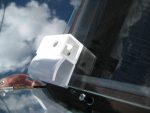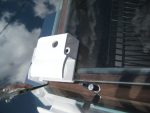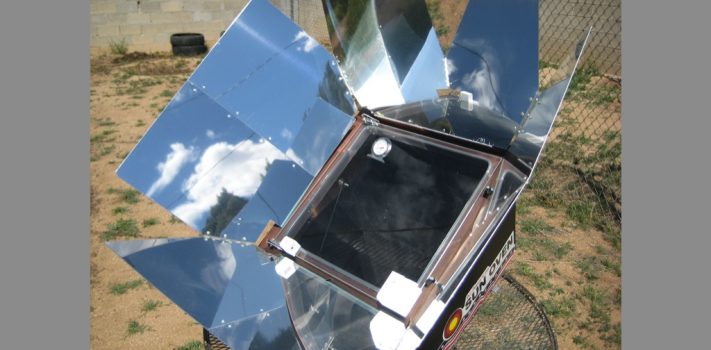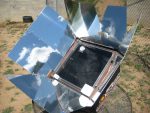I’ve had a Sunflair Deluxe solar oven for a few years now. I recently purchased an All-American Sun Oven. I cooked with both of them recently.
The Sunflair Deluxe is made of fabric and flexible plastic (to let the sun in), whereas the Sun Oven is a large box that does not fold, but the panels that reflect the sun into the oven that do fold. I don’t recommend cooking on a windy day with the Sun Oven. The sun-reflecting panels are too fragile. That’s not a problem with the Sunflair Deluxe, but one time the wind came up and blew it off the table where I had it set up, spilling my rice everywhere. After that, I placed a metal wood-splitting wedge in my Sunflair Deluxe to prevent it from being blown over. As a bonus, the metal wedge helps to absorb and radiate heat into the oven.
The Sun Oven (above) is larger than the Sunflair Deluxe (below). As you can see, the plastic is cracked on the Sunflair Deluxe. This is my second Sunflair Deluxe; when I saw the crack, I decided to upgrade to the Sun Oven.
My Sun Oven Tests
For my test run of the Sun Oven, I baked several thawed boneless, skinless chicken breasts which I had dipped in my mother’s mix of whole wheat flour and seasonings. I didn’t have to put any liquid in the pot. I let it cook for several hours. Maybe I cooked it too long; the chicken was a little dry. The Sun Oven came up to a little over 300 F; the Sunflair Deluxe rarely exceeds 250 F because it’s smaller. I used the Sunflair Deluxe to cook brown rice in the two collapsible silicon pots that it came with; that worked well, as always. Even though the Sunflair’s plastic cover cracked, which allowed outside air in, it worked well anyway because the cooking tray still had sunshine reflecting on it.
- Some tips on solar ovens, no matter what versions you buy:You must preheat it, just like a regular oven. Put it out in the sun and let it get warm for at least half an hour before you cook anything. If you plan to cook meat, thaw it first. Generally speaking, peak solar time is between 9 AM and 3 PM.
- Wear sunglasses; the reflective material used in any solar oven to reflect sunlight into the cooking chamber will also reflect a lot of sunlight into your eyes.
- The only way you can cook is on a sunny day. The outdoor temperature doesn’t matter too much; what matters is sunlight. If the weather in your area is cloudy or overcast most of the time, even during the summer, a solar oven might not be right for you.Be prepared to bring your food inside to cook on a conventional stove or oven if the day becomes cloudy; I’ve had to do that a few times. In other words, a solar oven is not a set-and-forget device. Don’t leave it unattended.
- Every 20-30 minutes, adjust the angle of the sun oven so that the sunlight is pouring into it directly. (See the note on alignment, below.
- Make sure that you use a pot or pan with a lid for whatever you’re cooking or baking. If you don’t, the moisture will evaporate and block the cover of the oven where the sunlight comes in. That will degrade the cooking process. This is more of a problem with the Sunflair Deluxe.
- Do not bake bread or anything that requires yeast, at least not in the Sunflair Deluxe. I tried that once and ended up with a big gooey mess of raw bread dough smeared all over inside. The Sunflair Deluxe doesn’t get hot enough to kill the yeast after you want the bread to stop rising. Though the Sun Oven is hotter, I’m afraid to try baking yeast bread. I’ll stick with using baking powder or baking soda.
My Sunflair Deluxe isn’t going to last much longer. When the crack in the plastic becomes too large, I’ll throw it out and not replace it. I don’t need two solar ovens.
Setting Proper Solar Alignment

 Proper alignment of your oven to match the sun as it tracks across the sky is important. The Sun Oven has a useful sighting device that used to position the oven with the sun shining directly toward the bottom of the oven. The photo at left shows the sighting device with the sun out of alignment. The photo at right shows the sighting device with the sun in the proper alignment. Note how the dot is centered in the circle in the photo at right. You can adjust alignment by a combination of rotating the box and adjusting the stand on the back of the oven.
Proper alignment of your oven to match the sun as it tracks across the sky is important. The Sun Oven has a useful sighting device that used to position the oven with the sun shining directly toward the bottom of the oven. The photo at left shows the sighting device with the sun out of alignment. The photo at right shows the sighting device with the sun in the proper alignment. Note how the dot is centered in the circle in the photo at right. You can adjust alignment by a combination of rotating the box and adjusting the stand on the back of the oven.
I like the durability, larger size, and higher temperature of the Sun Oven. It cost me about $500, including shipping. That’s almost 19 ounces of silver at the silver spot price posted on APMEX on 04-02-2024. (I’m glad I bought it two months ago; precious metals have been on a tear recently.) It’s an investment in being able to cook if the natural gas supply is interrupted or becomes more expensive, as some people seem to want. In a grid-down situation, having a solar oven will save you from a lot of wood collecting and chopping. You can also use a solar oven to pasteurize water. The Sun Oven company sells water pasteurization indicators. The Sunflair Deluxe is smaller and much lighter and comes with its own carrying bag; this makes it handy for camping.
Both companies sell their own solar oven cookbooks, keyed to each oven. However, I’ve managed to cook recipes that were written for conventional stoves or ovens. The only difference is that it can take longer, depending on which solar oven you choose to buy.
Solar Cooking is Fun
No matter what brand you buy, cooking with a solar oven is fun. The food tastes great. Meat is juicy if you don’t overcook it. You’re less dependent on the grid. As Richard Heinberg put it in The Party’s Over, “A meal consisting entirely of food that you have grown and that you have cooked slowly in a solar oven is truly a banquet of self-sufficiency.” No fussy electronics to worry about; solar ovens are EMP-proof! Best of all, many natural gas utilities are closely tied to governments. The less you need natural gas, the less money you’re giving to governments, which are frequently woke and incompetent. Saving money and starving the corporate/government beast – what’s not to love? Happy cooking!!












